User is king with flexibles.
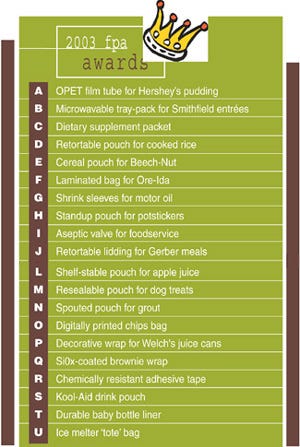
Innovations designed to meet user needs, through the use of new packaging materials, technologies and converting and printing expertise, abound in this year's group of award winners in the Flexible Packaging Assn.'s Packaging Achievement Competition.
Consumers will no doubt feel royal, as they're getting the packaging conveniences for which they have asked. The 21 inventive, winning packages– the majority of which are retail-oriented–received 27 awards out of a record-setting 87 entries in this year's program. They won gold and/or silver awards in four categories–packaging excellence, technical innovation, printing achievement and environmental achievement. And, for the third year in a row, two packages received the Highest Achievement Award.
So many of the winners were designed for the time-pressed, one has to wonder–is nearly everyone in that big of a hurry? Apparently they are, or soon will be, as the raft of new, retortable packaging materials, intricately printed shrink sleeves, single-use and portable structures described here are designed to captivate, protect, facilitate dispensing or even withstand hazardous conditions. Packagers benefit from highly machinable materials, too.
Some of the winners–a pouch for grouting tile, a brownie wrapper, a standup soft drink pouch and a packet for dietary supplements–address the need for product visibility and sparkling clarity, as well as package economies; others eliminate the need for utensils, additional preparation steps or the messy transfer of food from one container into another. Still others recognize functionality, improved barriers, freshness/shelf stability, clean opening features (peelability) or product dispensing ease or add new dimensions to retortable technology to render fully cooked, shelf-stable meals or snacks quickly and easily. In one case, a multilayer adhesive tape is now available that protects people from harmful chemical agents.
The flexible packaging winners also signify new dimensions in durability, structural stability and product integrity, demonstrating sophisticated converting and printing techniques, including digital direct-to-plate processes, and new ink systems.
Top honors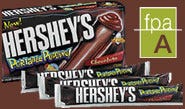 Two packages deemed tops at generating the most advances earned the Highest Achievement Award. One of them, for ConAgra Foods' Hershey's Portable Pudding! Stick Pack (A), a single-serve, 2.25-oz squeezable tube, from Curwood, Inc., also won a gold award for technical innovation and a silver award in environmental achievement. Claimed to be the first portion-controlled, aseptic stick package on the market, the tube-like package is made of a metallized oriented polyethylene terephthalate (OPET) film and requires no spoon.
Two packages deemed tops at generating the most advances earned the Highest Achievement Award. One of them, for ConAgra Foods' Hershey's Portable Pudding! Stick Pack (A), a single-serve, 2.25-oz squeezable tube, from Curwood, Inc., also won a gold award for technical innovation and a silver award in environmental achievement. Claimed to be the first portion-controlled, aseptic stick package on the market, the tube-like package is made of a metallized oriented polyethylene terephthalate (OPET) film and requires no spoon.
The tube-like structure is aimed at kids on the move and is shelf-stable for nine to 12 months. Portable and a lot of fun for kids to use (also see PD, July, '02, p. 42), the new pack is ideal for school lunch boxes.
ConAgra Foods, Irvine, CA, launched the package last year to rave reviews. Consumers are becoming more receptive to the convenience of stick packs and the lack of refrigeration they require, so the tube made of high-barrier film fits their needs. Easy to open by way of a tear notch, the tube material from Curwood is laminate that Curwood describes as an oriented polypropylene/ink/adhesive /metallized OPET/adhesive/ethylene vinyl alcohol coextruded sealant, reverse-printed by flexo in eight colors. The entire film tube is printed, so as to enhance the graphic appeal of the package, Curwood reports. Lightweight and slim, the stick also is said to reduce waste, packaging weight and storage space versus rigid pudding cups with film lids. Curwood says material costs are likely to be half of those for most rigid cups with lids.
ConAgra Foods developed the ready-to-eat snack through a licensing agreement with Hershey Foods Corp., and with Hershey, has created a new subcategory within the pudding products market. Though the pudding is aseptically packaged and is shelf-stable for up to 12 months, the product is sold refrigerated. If desired, the tube packs can also be frozen and eaten like a "freeze pop," but are also edible at ambient temperatures, they can be taken just about anywhere.
Curwood's Jeff Hopp, market manager of liquid packaging, says the rugged metallized film construction was designed to endure a peroxide bath just prior to filling. The structure is also claimed to machine well on a multilane aseptic packaging system from Hassia. The structure was also designed to provide substantial barriers to oxygen, moisture and peroxide. Multiples of eight 2.25-oz sticks come in a paperboard folding carton, brightly decorated with similar, chocolately wraparound graphics. Circle No. 231.
Smithfield's new tray-pack offers three steps to heat and eat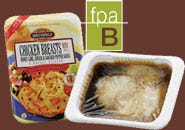 Time is precious. Today's shoppers look for meals that are quick, easy to prepare and delicious. Smithfield Packing Div. of Smithfield Foods, Smithfield, VA, is delivering, with an amazing nine meal choices that are fast, simple to prepare and healthy. The second Highest Achievement Award winner, a microwavable, completely film-covered, vacuum tray-pack, is now available from Smithfield Packing Co. for its new line of heat-and-eat entrées (B). Available in the fresh-meat case, Smithfield's version of the Cryovacw Simple Stepse vacuum-sealed package, from Cryovac Div. of Sealed Air Corp., replaces a tray with a microwavable boil-in-bag insert.
Time is precious. Today's shoppers look for meals that are quick, easy to prepare and delicious. Smithfield Packing Div. of Smithfield Foods, Smithfield, VA, is delivering, with an amazing nine meal choices that are fast, simple to prepare and healthy. The second Highest Achievement Award winner, a microwavable, completely film-covered, vacuum tray-pack, is now available from Smithfield Packing Co. for its new line of heat-and-eat entrées (B). Available in the fresh-meat case, Smithfield's version of the Cryovacw Simple Stepse vacuum-sealed package, from Cryovac Div. of Sealed Air Corp., replaces a tray with a microwavable boil-in-bag insert.
Also winning a gold award in packaging excellence, the new entrée package simplifies meal preparation with cook-in technology that allows Smithfield to use just one package to fully cook, ship and market the center-of-the-plate meat or poultry entrées. After purchase, consumers can simply heat the entrée in the microwave and in four minutes, it's ready to eat.
Simple Steps was at least two years in the making, says Jay Wilson, Cryovac's director of marketing for smoked and processed meats. Why the name Simple Steps? Because the product allows consumers to basically complete food preparation in three steps: 1) remove the tray from the outer package; 2) heat for the designated time (usually about 4 min); and 3) pull the easy-open tab to remove the vacuumized skin-film lidding. The product is ready to serve.
Based on Cryovac's Darfresh vacuum skin-pack technology, the package in Smithfield's case consists of a black thermoformed PP-based tray, drawn to a depth of 13/4 in., that's filled with the entrée and completely sealed with a polyolefin-based, coextruded barrier top web. The top web is typically 4 to 6 mils thick, Wilson says.
The pack is then vacuumized on a Darfresh T570 Multivac rollstock machine in place at Smithfield's Valley Dale Foods production facility in Salem, VA. The transparent skin-film lidding contours to the product like a second skin, giving the food an appetizing appearance and keeps meat looking juicy. The film also allows the product to be frozen in the original tray and be reheated later. The tray-pack is then encased in an outer Robbie PromoBag® heat-shrinkable film bag made by Robbie Mfg. of 75-ga Clysarw polyolefin film from DuPont, flexo-printed in nine colors.
"The separate, premade tray combined with the sealant film is what's really new here," Wilson explains, adding that as the vacuum is pulled, the film is heated to a temperature of at least 200 deg C and is pulled up about 50 mm, so it has to be extremely pliable. "As the vacuum is released and air pushes on top of the film, there is a draping or skin-packaging effect, which is a unique process," he tells PD.
"In the microwave, the self-venting system allows the vacuum skin-film to expand during reheating, to form a bubble that self-vents, then relaxes over the food," says Wilson. The film's automatic venting process requires that it be extremely pliable to "tent up," as the product heats, in a fashion similar to the bubble-up effect produced by a popcorn bag heated in a microwave oven.
The controlled self-venting film requires no puncturing. As the vacuum is released, air is pushed down onto the film web to achieve the skin contouring effect. The tray's "stay-cool" side handles prevent users from burning themselves as they remove the tray from the microwave. The easy-open film lidding can be peeled off after heating, without the need for scissors or knives, which prevents spills.
Smithfield's senior product manager of prepared foods Megan Benz says the entrées are intended for consumers who want easy-to-use meals that taste as good as they look in the meat case (see PD, February, '03, p. 4).
Wilson says Simple Steps is receiving interest from several packagers, and is also being or will be used for other heat-and-serve entrées by meat and poultry processors, as well as by packagers of nonmeat foods.
Cryovac says less overall packaging material is required in the Simple Steps tray-pack compared with other microwavable entrée packaging, because the food is vacuum-sealed and securely centered in the cook-in tray, so it doesn't need to be prepackaged in a separate pouch–a step saver on the processing side.
The versatile vacuum skin film provides several advantages, Wilson adds. "The total seal helps keep the product stationary in the tray and reduces leakers. The film contours to the food for a clear identification of the product and great merchandising appeal." The product can be laid out inside the tray to cook more evenly than if it were clumped together in a tight-fitting pouch, and is presented in an appetizing way.
With Simple Steps, processors can meet food safety and shelf-life requirements, while consumers benefit from the ease of preparation and serving. The package is easy to serve, as the easy-open, peelable tab opening eliminates the need to puncture or cut the film either before or after reheating. This prevents steam and splatters from burning fingers. Since the food can be eaten directly from the tray, there are fewer dishes to clean.
Benz says Smithfield is pleased with its new package, which rolled out in May to limited test markets in Chicago, Philadelphia, Denver and Florida. "We now offer nine fully cooked, premium entrées that include Beef Tips with Gravy, Caribbean Style Chicken, Mexican Pork, Italian Chicken and Pork Roast with Gravy. They're very easy to use and are doing well in the market." Circle No. 232.
Moisture-resistant supplement pack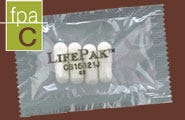 Packaging excellence is also apparent in a clear film packet (C) for LifePakw dietary supplement capsules available from Pharmanex, a Nu Skin Enterprises company, headquartered in Provo, UT. Sold primarily in Asia through a sales distribution network, the supplement capsules are formulated to "add years to your life and life to your years." Targeting and said to inhibit symptoms associated with aging, the product is contained within a four-side-sealed, primary film packet that must protect the supplement formulations from aging, as well, but especially protect them against moisture and oxygen. This became an issue until Pharmanex adopted a new film material from Rollprint Packaging Products. The NutraSeal film packet from Rollprint won a gold award in packaging excellence and a silver award in technical innovation.
Packaging excellence is also apparent in a clear film packet (C) for LifePakw dietary supplement capsules available from Pharmanex, a Nu Skin Enterprises company, headquartered in Provo, UT. Sold primarily in Asia through a sales distribution network, the supplement capsules are formulated to "add years to your life and life to your years." Targeting and said to inhibit symptoms associated with aging, the product is contained within a four-side-sealed, primary film packet that must protect the supplement formulations from aging, as well, but especially protect them against moisture and oxygen. This became an issue until Pharmanex adopted a new film material from Rollprint Packaging Products. The NutraSeal film packet from Rollprint won a gold award in packaging excellence and a silver award in technical innovation.
Pharmanex experienced performance foibles from moisture penetrating the previous packaging. The packets are shipped worldwide and are subject to all sorts of variables, so the company tried Rollprint's NutraSeal film, made with its ClearFoil® M aluminum-oxide-coated polyester film barrier, to improve oxygen- and moisture-resistance, that's coextrusion-coated with a blended metallocene sealant layer to improve sealing properties. The coex-coated polyester technology is convenient and cost-effective, Rollprint says, and contributes to a thinner-gauge package (about 1.25 mils) that can perform at high packaging speeds. The packet's aluminum-oxide-coated polyester layer acts as the moisture-vapor barrier, according to Rollprint's Jeffrey Seeck, manager of marketing and customer service. But Seeck says key to the structure is the polyolefin blend sealant that produces heat seals so strong, they won't break even if a person stands on the packet. Yet, the clear film packet is easy to open along its serrated edge.
"We spent more than a year working with different materials on this project before we came up with the ClearFoil polyester and metallocene combination," says Rollprint's Dwane Hahn. "There wasn't an off-the-shelf solution, so we combined some different technologies to develop a material that teams economics with significant moisture and oxygen barriers."
Less than 1 mil thick, the thin coex layer allows the packet to sustain high-speed machining, Hahn says. The material also exhibits a specific low slip level, or a tightly controlled coefficient of friction (COF), in order to function well on high-speed tablet-packing equipment. The COF makes the supplement capsules actually cling to stay in place in the film while the packets are filled and sealed, PD is told. Rollprint produces 121/4-in.-wide rolls of the packet film, and sends them to Multi-Pak in Chatsworth, CA, which packs the supplements for Pharmanex on custom forming, filling and sealing equipment. The packets are merchandised 30 per paperboard carton.
Care must be taken to handle aluminum oxide coatings, Seeck adds. "If unprotected or in an unconverted form, they can be subject to flex cracking. So a coating-manufacturing process was developed to ensure the coating can survive thermal shock and other stresses, and provide a structure that is unaffected by ambient humidity levels."
The base film, he says, is produced in a single manufacturing step, and he pegs NutraSeal's moisture vapor transmission rate at 0.08 g/110 in. 2 for 24 hr or better.
Since converting to the new flexible structure, Pharmanex reports a drop in failure rates to one-tenth of one percent (0.1 percent). About 50-percent thinner than previous packet structures, the new 3 x 2-in. supplement packet achieves the proper barriers and sealability. Hermetic sealing also protects the capsules and tablets, says Seeck. "Since the capsules and tablets are very moisture-sensitive, prior packaging structures suffered failure rates as high as twenty percent, particularly in high-moisture environments, such as Southeast Asian markets, where the majority of the supplements are sold. The tablets were previously prone to discoloring and crumbling." The new film's glass-like clarity improves packet appearance. Circle No. 233.
Retort pouch sizzles for cooked rice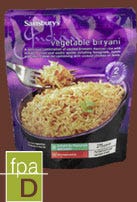 Until recently, the words "retortable" and "pouch" weren't often linked together. Now, a ready-to-eat cooked rice in a glamorous standup retortable pouch is a reality, courtesy of a striking package developed by CLP Industries Ltd. and Sainsbury's supermarkets in the U.K. The two have found a way to offer a microwavable cooked rice side dish line (D) that may just take Great Britain by storm.
Until recently, the words "retortable" and "pouch" weren't often linked together. Now, a ready-to-eat cooked rice in a glamorous standup retortable pouch is a reality, courtesy of a striking package developed by CLP Industries Ltd. and Sainsbury's supermarkets in the U.K. The two have found a way to offer a microwavable cooked rice side dish line (D) that may just take Great Britain by storm.
The pouch is so convenient, elevates the white rice to new heights in the premium, heat-and-serve category, and at the same time, won CLP a gold award in packaging excellence. Available in five rice varieties, the 275-g (9.7-oz) pouch is shelf-stable up to 12 months, thanks to a high-barrier, clear-film laminate. After a corner of the film material is cut or torn open for venting, the pouch can be placed in the microwave and heated on full power for two minutes. The rice is then ready to eat.
According to Leslie Gurland, president of CLP Packaging Solutions, the Fairfield, NJ, arm of CLP Industries based in Israel, the pouch was designed to resist the extremes of the retort process as well as drop-test requirements. Measuring 637 in., the glossy adhesive laminated pouch comprises a silicon oxide-coated 48-ga polyethylene terephthalate glycol (PETG)/60-ga biaxially oriented nylon/2.4-mil cast PP.
Gurland says Sainsbury's wanted a high-end, nonfoil pouch that could be retorted and heated in the microwave. Despite the lack of a foil layer, the resulting combination, including the SiO2 coating, affords the shelf life Sainsbury's wanted. The microwavable pouch also has the necessary oxygen and moisture barriers needed to handle shipping and retorting extremes, while the absence of foil permits packaging designers to create transparent packages or windowed pouches, though Sainsbury's uses opaque pouches.
CLP Industries says it produces the pouch in Kubbutz Negba, Israel, adhesive-laminating the films on a Rotomec system from Valmet Converting. Providing a strong shelf presence, the appetizing graphics are reverse-gravure-printed in eight colors on a Cerutti 1,270-mm-wide (50-in.) press with an attention-getting, deep purple background color aimed to jump off of store shelves. The finished filmstock is then made into pouches on Totani equipment (available in the U.S. from Amplas).
CLP then sends the pouches to Wales where the product is filled, hermetically sealed and cooked and retorted by FE International Foods, which was instrumental in the pouch's development for Sainsbury's, PD is told. The pouches are retorted in a pure sterilization process by a LaGarde retort chamber from France (provided in the U.S. through Container Machinery Corp.).
CLP rates the oxygen permeability to be less than 1 cc3/m2/24 hr, which contributes to the product's considerable shelf stability. What's more, the retorted pouch represents a key weight and source reduction versus rigid cans and bottles.
Gurland says at least one U.S. company could soon roll out a similar retort pouch for cooked rice. "This only took us six months to develop," she says. "We have a lot of the technology already in place for such applications." Circle No. 234.
Beech-Nut cereal pouch packs babies-to-go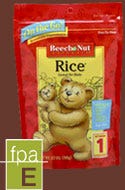 Another most impressive flexible package comes from Beech-Nut Nutrition Corp. and Amgraph Packaging, which won a gold awards for both environmental achievement and printing achievement, as well as a silver award for packaging excellence. Beech-Nut Natural's new standup zippered pouch for infant rice cereal (E) joins the dry cereal product's folding carton in the packaging lineup. The multiserving, 3.7-oz standup pouch offers a new look and feel in packaging for such a product. The bright red pouch has a resealable zipper closure that allows the package to be easily stored, carried and resealed.
Another most impressive flexible package comes from Beech-Nut Nutrition Corp. and Amgraph Packaging, which won a gold awards for both environmental achievement and printing achievement, as well as a silver award for packaging excellence. Beech-Nut Natural's new standup zippered pouch for infant rice cereal (E) joins the dry cereal product's folding carton in the packaging lineup. The multiserving, 3.7-oz standup pouch offers a new look and feel in packaging for such a product. The bright red pouch has a resealable zipper closure that allows the package to be easily stored, carried and resealed.
"The reason for putting this product in a pouch is the on-the-go concept," says Beech-Nut purchasing manager Dan Moynihan. "It's the kind of thing that can be transported in a diaper bag because it's reclosable."
Available in stores for about a year, in a material that's nearly 4 mils thick, the package is a proprietary combination of polyester substrates that Amgraph's new products development/marketing services manager Mike Drab says includes a clear polyester laminated to an opaque white combination high-density/low-density polyethylene, that gives the graphics a bright, eye-popping appearance and color contrast.
Though it contains no foil, which usually aids deadfold characteristics, the film laminate is stiff enough to hold its shape while being filled, yet isn't so thick that the use of high heat and long dwell times are necessary to seal the pouch. Amgraph offset-prints the pouchstock on a Hamilton Stevens offset press in six colors. Electron-beam-cured water-based inks and lacquers and a water-based inking and lacquering system are used to promote scuff-resistance and gloss. The solventless inks and lacquers allow Amgraph to print the filmstock without odors, volatile organic compounds (VOCs) or solvents, Drab points out.
The pouchstock is shipped as rollstock about 24 in. wide O.D. to Beech-Nut's contract packager, Roberts Packaging. There, the pliable, durable material is made into standup pouches on Roberts' continuous-motion C Series horizontal form/fill/seal machinery. Application of the Presto Fresh-Lockw 213 press-to-close zipper closure is performed in-line during pouchmaking, which reaches speeds averaging 140 to 150/min. Drab says the pouchstock was made to machine well yet still look glossy and crisp on a store shelf. "The white heat-seal film has a broad sealing range, excellent hot tack and low-temperature sealing properties," Drab adds
Moynihan says that the rice cereal has been a best-seller in the carton. "If the pouch sells well, then we may use it for our other product varieties." Circle No. 235.
Flexo lamination triggers tastebuds for spuds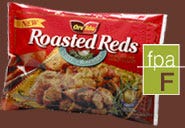 An eye-catching bag for Heinz Frozen Foods' new Ore-Ida® Roasted Reds Garlic and Rosemary potatoes (F) struck gold for Pliant Corp., in the printing achievement category. The bag is a flexo-printed lamination that provides outstanding shelf presence. The new potato pouch uses the bright red associated with Ore-Ida, along with tantalizing food photography to beckon consumers visiting the freezer case. The savory, seasoned potato wedges were introduced nationwide last November in a 4-lb, 15 x 10-in. resealable pillow-pack, expertly printed in eight colors.
An eye-catching bag for Heinz Frozen Foods' new Ore-Ida® Roasted Reds Garlic and Rosemary potatoes (F) struck gold for Pliant Corp., in the printing achievement category. The bag is a flexo-printed lamination that provides outstanding shelf presence. The new potato pouch uses the bright red associated with Ore-Ida, along with tantalizing food photography to beckon consumers visiting the freezer case. The savory, seasoned potato wedges were introduced nationwide last November in a 4-lb, 15 x 10-in. resealable pillow-pack, expertly printed in eight colors.
Heinz Graphics produced the artwork for the zesty bag, while Pliant Corp. produces the printed rollstock, complete with a zipper. Pouchstock is made from a surface-printed, 2.5-mil polyethylene laminated with solventless adhesive to a 48-ga polyester sealant layer. Says John McCurdy, director of corporate communications for Pliant, "The package incorporates a flexographically-printed lamination versus a typical surface-printed low-density polyethylene to provide excellent shelf impact."
The graphic presentation is further enhanced, McCurdy adds, by Pliant's use of an all-digital prepress workflow, facilitated by computer-to-plate equipment from Barco Graphics. "We believe that because of the way the [printing] plates are produced, the image quality is far superior to what you would get from conventional platemaking," McCurdy says. But the most challenging aspect of the job, relate press operators producing the printed rollstock in Pliant's Macedon, NY, facility, was putting the "zing" in the Ore-Ida red. "From the standpoint of our customer, that was the one thing they really wanted us to nail," McCurdy notes. Success was achieved by using a double-bump of red on a Windmoeller & Hoelscher Stellaflex flexo press, with an ink system supplied by Sun Chemical Corp.
For consumer convenience, a reclosable zipper runs along the right-hand side of the potato pouch. Pliant adds the zipper to the printed rollstock at its Kent, WA, facility, using Hudson-Sharp's Inno-Lok® system. The system places the zipper transverse to the package-forming direction for bagmaking on form/fill/seal equipment. The rollstock, with zipper, is then sent to The NorSun Food Group in Sugar City, ID, which supplies the packaged product to Heinz. Circle No. 236.
Shrink sleeves drive motor oil bottles into high gear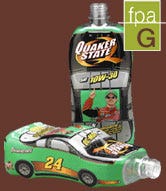 A pair of speedy, snug-fitting shrink-sleeve labels covering a new set of racecar-shaped bottles is attracting plenty of attention to Pennzoil-Quaker State's motor oil (G). The attractive and exciting sleeves won SleeveCo a gold award for printing achievement. SleeveCo's Jennifer Helms says nothing has changed since PD last covered the packages (see PD, Nov. '02, p. 58), which were launched in November, '02. Contract-labeled by Easy Contract Labeling, the bottles replace standard-shaped oil containers with paper labels. The 2-mil, full-body polyvinyl chloride sleeves are vibrantly printed by gravure in seven colors with graphics depicting Quaker State's Number 24 Nascar driver, Jeff Gordon, and are fitted around the uniquely shaped, thin-walled, 32-oz PET bottles for incomparable shelf presence and consumer appeal.
A pair of speedy, snug-fitting shrink-sleeve labels covering a new set of racecar-shaped bottles is attracting plenty of attention to Pennzoil-Quaker State's motor oil (G). The attractive and exciting sleeves won SleeveCo a gold award for printing achievement. SleeveCo's Jennifer Helms says nothing has changed since PD last covered the packages (see PD, Nov. '02, p. 58), which were launched in November, '02. Contract-labeled by Easy Contract Labeling, the bottles replace standard-shaped oil containers with paper labels. The 2-mil, full-body polyvinyl chloride sleeves are vibrantly printed by gravure in seven colors with graphics depicting Quaker State's Number 24 Nascar driver, Jeff Gordon, and are fitted around the uniquely shaped, thin-walled, 32-oz PET bottles for incomparable shelf presence and consumer appeal.
According to SleeveCo, complex distortion factors had to be calculated when designing and printing the sleeve labels in order for them to fit properly on the clear, blow-molded bottles from Aquapac. But the efforts were worth it; the "car" containers have created so much excitement in the mature motor oil market that Pennzoil-Quaker State can run a victory lap. The square bottles posed not only a distortion issue during shrinking and had to be registered horizontally and vertically onto the bottle, but the illustrations also had to match up exactly to the bottles, especially where special ridges on bottles and sleeves created the look of tires and where tires would actually be located, SleeveCo says. To remedy these issues and achieve uniform coverage SleeveCo used a film with a grid design for registration.
Easy Contract Labeling applied the sleeves to the bottles on modified application equipment including custom shrink tunnels. Extra inspections and manual sleeve registration ensured a proper fit. "We went through weeks of R&D for the project," reports Helms. "The use of shrink labels with such a severe distortion issue and difficult application has rarely been done before." Circle No. 237.
Gravure-printed pouch for potstickers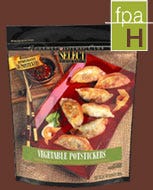 Gravure never looked so good as it does on the slick, sophisticated standup pouch produced for Safeway's Vegetable Potstickers (H), which took home a gold award for printing achievement.
Gravure never looked so good as it does on the slick, sophisticated standup pouch produced for Safeway's Vegetable Potstickers (H), which took home a gold award for printing achievement.
A Safeway Select™ Gourmet Club item, the cook-and-serve vegetable dumplings, previously packed in paperboard cartons, were restaged in the stylish, resealable pouch in October, '01, for added "freezer presence" and consumer convenience.
Under Safeway's direction, Mississauga, ON-based Destination Products Intl., a supplier of private-label frozen foods, carried out the flexible package design with converter Nordenia USA of Jackson, MO.
According to Dan O'Brien, sales & marketing manager for specialty products at Nordenia, the bag's film construction–a 48-ga polyester laminated with solventless adhesive to a 4-mil, white polyester sealant layer–was chosen for its printability, its machinability, and its ability to protect bag contents from freezer exposure.
Furthermore, the bag's standup structure "makes selection and handling of the product more convenient," he adds, "and greatly enhances the presentation of the product to the consumer."
Covering nearly the entire front panel of the 26-oz-capacity pouch is photography of the potstickers, tastefully arranged on a vibrant red serving tray, accompanied by Chinese-style accessories. To capture the vivid, detailed graphics, Nordenia chose the gravure printing process, using an eight-color Windmoeller & Hoelscher press. "Upscale, photographic-quality graphics and gravure printing give this package a visual marketing advantage over other packaging typically found in this market segment," says O'Brien.
To further enhance the graphic quality of the pouch, Nordenia reverse-prints the design on the high-gloss polyester outer layer using transparent, fade-resistant inks from Siegwerk that are specifically designed to provide excellent color strength and lamination bond properties. Also ensuring a high lamination bond strength and excellent, post-lamination package appearance is a special 100-percent-solids adhesive system from Rohm and Haas.
Although printing of the film required strict control of color tolerances and tight registration across a wide-web press (up to 79 in.), the process allowed Nordenia to produce a six-color pouch with the appearance of an eight-color job, with reduced prepress and cylinder costs.
After being printed and laminated, the film is handed over to Nordenia's extensive bag converting department. In this area, a zipper is applied to the pouch film, which is then converted into the final standup pouch format, with an easy-tear opening at the top.
According to O'Brien, the magnificent end result of the potsticker pouch can be attributed to Nordenia's control of the converting process, which extends from sealant-film extrusion through gravure cylinder engraving, to printing, laminating, slitting and bagmaking. "This is a perfect example of how well Nordenia works with supplied artwork, and how much we can continue to ensure the quality of that artwork through the finished product with our presses and with our in-house capabilities," he says. Circle No. 238.
Foodservice gets a handle on dispensing valve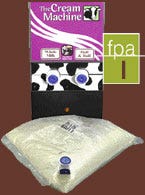 The Aseptic Gravity Flow Valve™ (I) from International Dispensing Corp. (IDC) won a gold award for technical innovation. Receiving patent approval last September, the valve "will do for flexible packaging what the push-pull cap is doing for single-serve PET bottles," says IDC president & CEO Gary Allanson. "It is an enabling technology that will open new products to large-sized bags and pouches," he explains.
The Aseptic Gravity Flow Valve™ (I) from International Dispensing Corp. (IDC) won a gold award for technical innovation. Receiving patent approval last September, the valve "will do for flexible packaging what the push-pull cap is doing for single-serve PET bottles," says IDC president & CEO Gary Allanson. "It is an enabling technology that will open new products to large-sized bags and pouches," he explains.
IDC designed the valve, a five-piece, pushbutton fitment, for both the filling and dispensing of aseptic product from flexible packaging ranging in size from 2 to 10 L. Constructed using the GFV Tight Seal™ design, which creates an oxygen and bacteria barrier, and with a built-in, tamper-evident, breakaway closure, the valve allows foodservice operators to dispense ready-to-drink products, such as isotonic energy drinks, 100-percent fruit juices and dairy products from any flexible bag, pouch or semi-rigid package.
According to IDC, the valve is the only aseptic gravity flow valve worldwide that is capable of meeting the rigorous U.S. sterilization protocol required in the aseptic filling process. In fact, it exceeds the aseptic criteria. And, since last October, IDC, in cooperation with the Food and Drug Administration, the National Food Labs and Parkerford, PA-based Goodwest Industries, has been working to certify its technology as a single-fitment dispenser. "Once this certification is finished," says Allanson, "food and beverage companies will save forty to fifty percent on a flexible bag, because the package will only require one fitment."
Goodwest, a distributor of Parmalat aseptic dairy products for foodservice use, has chosen the valve for use with its Cream Machine™ cream and milk dispenser. Says Bill Goodwin, CEO of Goodwest, "IDC's Aseptic Gravity Flow Valve has helped us capture new customers and expand our product offering, resulting in double-digit, top-line sales growth." Goodwest president Jim West adds that the company expects the IDC dispenser to drive incremental dairy sales by as much as 30 percent. Circle No. 239.
Retortable lidstock tops Gerber entrées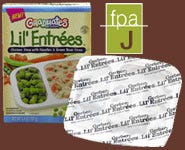 Little consumers and their parents are sure to enjoy the benefits of Gerber/Novartis' Graduates Lil' Entrées, which are not only handy in divided microwavable plastic containers but they're also retorted–considered a technical breakthrough for such a product and package configuration. The products are aimed at toddlers up to four years old, who have "graduated" from baby food but aren't yet ready for "grown-up" meals. Easy to open, thanks to an easy-to-peel lidstock (J) from Pechiney Plastic Packaging, the package includes a multilayer barrier tray thermformed by Rexam Containers that's covered with the high-barrier, proprietary multilayer film lidstock.
Little consumers and their parents are sure to enjoy the benefits of Gerber/Novartis' Graduates Lil' Entrées, which are not only handy in divided microwavable plastic containers but they're also retorted–considered a technical breakthrough for such a product and package configuration. The products are aimed at toddlers up to four years old, who have "graduated" from baby food but aren't yet ready for "grown-up" meals. Easy to open, thanks to an easy-to-peel lidstock (J) from Pechiney Plastic Packaging, the package includes a multilayer barrier tray thermformed by Rexam Containers that's covered with the high-barrier, proprietary multilayer film lidstock.
Pechiney converts and reverse-gravure-prints the proprietary lidstock in one color with the brand's logo in a repeating pattern.
The dual-compartmented tray pairs 6.6 oz of two preservative-free, baby/toddler foods and is packed in an outer paperboard carton from Caraustar, printed with a photo vignette that shows the meal pairings in the open tray.
An alternative to glass jars and metal cans for baby/toddler foods, the new package can be microwaved for up to 30 seconds after the lidding is punctured for venting. Winning a gold award for technical innovation, the retorted package carries a one-year expiration date, PD is told.
Part of Gerber's movement to plastic packaging for baby foods (see PD, Sept. '02, p. 60), the portioned entrées package meets the needs of busy parents who want foods for their children to be handy, tasty and easy to use anywhere.
Available in three Graduate varieties and three Third Foods varieties, the meals, such as chicken stew with noodles and diced green bean, are portable, designed to be balanced and can be eaten directly from the container, eliminating the need for separate food containers.
Break-resistant and lightweight, the package has no sharp edges and the lidstock eliminates the need for a plastic overcap for storage.
Pat Dwire, Pechiney Plastic Packaging's business development manager, says the unique, nonfoil adhesive-laminated lidstock was developed to provide microwavability and structural performance at retort temperatures of 250 deg F. High oxygen barriers both prior to and after retorting are crucial, as retorting affects many materials, Dwire says.
"The package lidding was tested in both pre- and post-retort conditions to make sure it had the necessary oxygen barrier. Moisture barriers, peelability, and sealability were also crucial. And it had to maintain a hermetic seal after retorting and during distribution."
While the package is unique for baby/toddler foods, surprisingly, Dwire says, there are an amazing number of retortable lidstocks for plastic film trays out there. "Retortable plastic containers are by no means new, but some have taken a while to get to market, or perhaps they've been somewhat hidden from the national retail product scene. But now there are more of them for a variety of products in distribution to grocery store chains."
Freemont, MI-based Gerber Products, a Novartis company, introduced Lil' Entrées nationally in August, '02. "They're the first low-acid, shelf-stable baby-toddler food combinations available in a multi-compartment, heat-sealed tray," states Chad Beachum of Gerber Products. "Gerber continues to bring technical packaging innovation into the market, while focusing on the developmental appropriateness of the products themselves." Circle No. 240.
Shelf-stable pouch for juice concentrates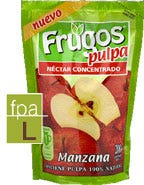 A shelf-stable, PET standup pouch containing 200 mL of 100-percent natural fruit juice concentrate is now available in Peru from Corporación J.R. Lindley, a joint-venture partner with Coca-Cola. The package for Frugos Pulpa de Manzana Frugos (the Frugos name combines the words Fruta for fruit and jugos meaning juices, PD is told) is a hot-filled pouch (L) from Peruplast S.A developed to provide notable convenience, easy-opening and pouring features and shelf stability for the new products for up to eight months, depending on the juice variety. J.R. Lindley offers the concentrate in apple, peach and mango as well as orange, the latter of which it says has a shelf life of about four months. The pouch won a silver award in packaging excellence for what Peruplast describes as a vibrant look, and for vividly printed graphics, break-resistance, space-efficiency and consumer-friendliness. Augusto Rey, technical manager at J.R. Lindley in Lima, describes the new pack as convenient for consumers, which, he says, is its main reason for being. The small pouch holds enough juice concentrate to make 1L when water is added. Filled at J.R. Lindley's "frutos" plant in San Juan de Lurigancho, the product is sold in various stores in Lima and is expanding to other areas in Peru.
A shelf-stable, PET standup pouch containing 200 mL of 100-percent natural fruit juice concentrate is now available in Peru from Corporación J.R. Lindley, a joint-venture partner with Coca-Cola. The package for Frugos Pulpa de Manzana Frugos (the Frugos name combines the words Fruta for fruit and jugos meaning juices, PD is told) is a hot-filled pouch (L) from Peruplast S.A developed to provide notable convenience, easy-opening and pouring features and shelf stability for the new products for up to eight months, depending on the juice variety. J.R. Lindley offers the concentrate in apple, peach and mango as well as orange, the latter of which it says has a shelf life of about four months. The pouch won a silver award in packaging excellence for what Peruplast describes as a vibrant look, and for vividly printed graphics, break-resistance, space-efficiency and consumer-friendliness. Augusto Rey, technical manager at J.R. Lindley in Lima, describes the new pack as convenient for consumers, which, he says, is its main reason for being. The small pouch holds enough juice concentrate to make 1L when water is added. Filled at J.R. Lindley's "frutos" plant in San Juan de Lurigancho, the product is sold in various stores in Lima and is expanding to other areas in Peru.
Peruplast produces the pouchstock from a durable, temperature-resistant lamination comprising PET from Mitsubishi and Hostaphan/ink/ adhesive/foil/adhesive and a coextruded sealing layer incorporating two different resins from Dow. The side adhesive-laminated to the foil carries a film based on a Dow low-density PE resin with a melt index of 0.7, notes Peruplast's Hans Traver. The other side of the sealing layer is Dow's Elite 5401 enhanced-performance PE copolymer resin, produced via Insite polymerization technology. This material, Traver says, affords a sealant with a lower sealing temperature than standard PE, which "makes for a strong seal, and has vastly superior resistance to impacts and perforations, compared to conventional polyethylene."
Peruplast reverse-prints the clear PET film layer by gravure in eight colors on a Grafomac press from Italy, using inks from Sinclair and Sun Chemical and a Novacote adhesive. The resulting 125-micron-thick material is formed into pouches, hot-filled at 85 deg C (185 deg F) and sealed on a Bosch form/fill/seal pouching system at roughly 40 packs/min, Rey tells PD.
"After conducting a market study, we saw the opportunity to substitute a large market niche of about 150 million liters of homemade juice," Rey says. "We had the challenge of changing a concept, which is almost a way of living, that includes buying, washing, peeling and blending fruit and adding water and sugar to make one or two litres of homemade juice."
Lindley's highly convenient alternative offers consumers in Peru a ready-to-make 100-percent juice, Frugos Pulpa. No sugar is needed, which saves time, effort and money yet we have a flavorful juice, Rey says.
"This minimizes all of the hassle consumers use to have. Consumers preferred an appealing package with attractive, full-color graphics, that's easy to handle and is low in cost. The pouch had to withstand hot filling and had to look different that our current Frugos nectars sold in glass bottles and in drink boxes. The 200-millilitre flexible, standup pouch is unique for our productand is a success."
Twelve pouches are multipacked for sale in a paperboard display box, which has been available for six months. "Sales are growing beyond our expectations, without cannibalizing our nectars line," Rey adds. "Soon, we'll add a new flavor called Tropical, which is a mixture of passion fruit, pineapple and banana." Circle No. 242.
Upstanding pouch for pooches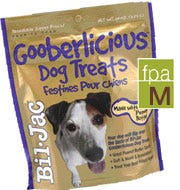 An upstanding pouch for Bil-Jac Gooberlicious Dog Treats (M) from Pechiney Plastic Packaging and New England Extrusion (NEX) contains 10 oz of peanutty treats for pooches from Bil-Jac/Kelly Foods. Resealable, courtesy of a zipper at the top and easy to open via a tear device, the pouch won a silver in packaging excellence.
An upstanding pouch for Bil-Jac Gooberlicious Dog Treats (M) from Pechiney Plastic Packaging and New England Extrusion (NEX) contains 10 oz of peanutty treats for pooches from Bil-Jac/Kelly Foods. Resealable, courtesy of a zipper at the top and easy to open via a tear device, the pouch won a silver in packaging excellence.
The unforgettable reclosable Gooberlicious pouch is made of a PET/metallized PET/NEX Grade M0086 Inflex sealant web. The Inflex sealant web grade from NEX has specific properties that, combined, can't be found using standard PE films, PD is told, such as increased stiffness and improved seal strength, gloss and haze. The M0086 can also be downgauged to reduce costs, as well as to reduce sealing temperatures.
The NEX Inflex sealant web M0086 was selected because of the added stiffness it offers at a thinner gauge than would have been possible with an ordinary LLDPE film, says Pechiney's Dan Brewer. Inflex films have stiffness without negatively affecting the other important properties such as seal strength and hot tack. The stiffness of the lamination works well and the pouches stand upright and present well on the retail shelf. "This is a thinner film with superior performance. We're hoping that it shows that there is more to a polyethylene sealant than just being a commodity product," says NEX's Steve Kelly.
Bil-Jac, Medina, OH, started production with the Inflex-containing film in June. This single film selection translates into a multilevel total cost reduction if compared to a standard LLDPE sealant. The thinner-gauge film ensured a finished lamination having 15-percent more lineal feet per roll at the same roll diameter as a standard PE sealant used in similar applications. This saved 15 percent in inventory and lowered equipment downtime because fewer roll changes were needed with lower scrap levels. In addition, more product can be packaged in less material, and the overall package weight per-unit is lower.
Consumer-friendly, durable and tough enough to hold up well during distribution, the package with the Inflex sealant also demonstrates good barrier properties and hot tack. The Inflex sealant is also claimed to provide for a 10- to 15-deg reduction in seal temperature when compared to conventional PE sealant films used for this type of application. Its light weight and small size also make it portable and distribution-savvy, while a zipper makes it reclosable. Circle No. 243.
Spouted pouch for grout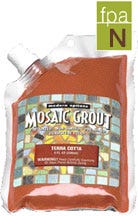 As any homeowner knows, digging grout out of a rigid container can be a tedious and messy business. And, the product could dry out if the container is opened for subsequent uses. The new Triangle Coatings Grout Pouch (N) that won Specialty Films & Associates a silver in packaging excellence eliminates such concerns.
As any homeowner knows, digging grout out of a rigid container can be a tedious and messy business. And, the product could dry out if the container is opened for subsequent uses. The new Triangle Coatings Grout Pouch (N) that won Specialty Films & Associates a silver in packaging excellence eliminates such concerns.
Representing a new type of package in its market, the spouted grout pack replaces rigid acrylic bottles with a hermetically sealed format with a clear front panel that reveals the color and consistency of the grout immediately to consumers. The package's hermetically sealed spout provides a unique method of applying the grout directly from the package, eliminating the need for troweling, remixing and spatula application. Made of a soft, resilient multilayer laminate, the pouch invites inspection and almost "asks" consumers to feel the product through it. This further allows consumers to "remix" the grout, by massaging the pouch.
Supplied by Specialty Films & Associates, LLC, the grout pouch improves upon rigid containers by utilizing several custom features in its design, and at the same time, incorporates a high-clarity substrate for strong visual appeal and customer convenience. A simple twist of the cap on top provides easy consumer access to the product.
The 41/2371/2-in.-high pouch contains 8 oz of product, and is made from two webs of material. The front web consists of a 48-ga PET front panel and a clear LDPE back panel with an adhesive center layer, while the back web is the same except for a white LDPE back panel.
"This was a fast-track project," says Specialty Films' Robert Ormsby. "Triangle contacted us initially in January, 2002, and we shipped them pouches for testing by March. The pouch was on the market by April."
Designed to enhance the consumer view of the various different colors of grout, as well as provide for a convenient and innovative tool for the mixing and dispensing of the product, the pouch also adds another dimension to the purchasing decision by now adding the sense of touch to customer's decision-making process. While the clear front panel lets consumers see the grout color, it also allows for an unprinted pouch design to fill small-quantity orders or custom colors by integrating an adhesive label to identify the merchandise versus the expense of costly short-run printing.
Shelf life after opening the grout has improved, as the air remaining in the pouch can be eliminated by holding the fitment upward and lightly squeezing until the remaining product reaches the top of the fitment. Circle No. 244.
Digitally printed chips bag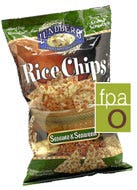 Triangularly shaped rice chips are a new product on the natural/organic/specialty food scene. Packaging for the textured rice chips, available from Lundberg Family Farms, a Richvale, CA, family-owned and operated farm that primarily produces and markets brown rice, special rice varieties and brown-rice products, had to convey a high-quality look to match the high-quality composition, according to Lundberg. To display the unusual looking chips prominently, Lundberg selected a beautifully printed 6-oz bag (O) from Progressive Packaging Ltd. that received a silver award in printing achievement.
Triangularly shaped rice chips are a new product on the natural/organic/specialty food scene. Packaging for the textured rice chips, available from Lundberg Family Farms, a Richvale, CA, family-owned and operated farm that primarily produces and markets brown rice, special rice varieties and brown-rice products, had to convey a high-quality look to match the high-quality composition, according to Lundberg. To display the unusual looking chips prominently, Lundberg selected a beautifully printed 6-oz bag (O) from Progressive Packaging Ltd. that received a silver award in printing achievement.
Reaching a new level in converting expertise and outstanding printed imagery, the crisp, richly printed filmstock for the 7 x 12-in. pillow-style bag is described as a two-ply polyester extrusion lamination with a specially blended sealant layer, having a total thickness of approximately 3 mils. Progressive Packaging extrusion/laminates the materials and then reverse-prints them with mouth-watering photographic reproductions in nine colors. What's notable here is the converter's use of a new Fischer & Krecke central-impression 10-color, gearless flexo press that Progressive's Andy Valy says offers many new technical benefits, including faster setup and more printing control. Enhancing shelf display impact, the glossy film bag material is printed three-up, using a 120-line screen with a 1-percent minimum dot gain, which Valy says makes the graphics jump off the web.
"This technology gives us much more control over printing without the restriction of a particular gear size," he says. "Servo drives control register and size as well. We have plenty of freedom to create designs with a lot of colors using this press." He says Progressive also used digital separations and new digital, thermally developed printing plates to achieve a sophisticated graphic design for four chip flavors: Sesame & Seaweed; Santa Fe Barbecue; Original Sea Salt; and Pico de Gallo. Bag graphics present a large photo vignette of a heaping bowl of chips with key ingredients displayed below.
Finished rolls of the bagstock are roughly 15 in. wide. Progressive sends the film rolls to Lundberg's copacker, Warnock Foods in Madeira, CA, where the stock is formed, gas-flushed, filled with chips and sealed on Hayssen/Eagle equipment. The filled bags are gas-flushed with nitrogen to keep the chips fresh for an impressive 10 months.
According to Valy, no special inks or coatings were needed to achieve the superior graphic reproductions. "It's a beautiful package," says Lundberg's vp of sales and marketing Tim O'Donnell. "This is a new product concept for us–we're a rice company in California, so we're excited about the product and its package. We're just now filling the distribution system with product, but so far, the product's doing very well on the market." Lundberg introduced the 6-oz bag of its new Rice Chips product in the fall of '02. Retailing at $2 to $2.49, the 6-oz bag is available in natural-food sections and specialty food stores across the country. Circle No. 245.
Juiced up wrap for Welch's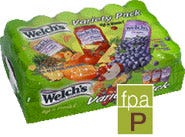 A 24-pack unitizing 11.5-oz cans of three different Welch's juices is now dressed up in a handsome PE film wrap from Bemis Polyethylene Packaging Division (P). The film-wrapped Welch's Variety Pack multipack could be a first for cans of fruit juice drink (see PD, September, '02, p. 4).
A 24-pack unitizing 11.5-oz cans of three different Welch's juices is now dressed up in a handsome PE film wrap from Bemis Polyethylene Packaging Division (P). The film-wrapped Welch's Variety Pack multipack could be a first for cans of fruit juice drink (see PD, September, '02, p. 4).
Awarded a silver in printing achievement, the 3-mil coextruded low-density polyethylene shrink film wrap replaces a printed corrugated tray with a placard card and a plain PE film wrap. Engineered to shrink in the right places without graphic distortion, the wrap presents vibrant graphics designed by Wright Design that spark shelf appeal and help consumers make quick work of purchasing decisions at point-of-sale. Bemis reverse-prints the material by flexo in eight colors with eye-catching graphics with color separation performed by MacKay Graphics. The design presents the cans of the juice varieties surrounded by the respective fruit ingredients they contain. Adorned with the Welch's logo and a grape and lime green color scheme, the results immediately communicate the package contents to consumers.
The warehouse club pack contains eight 12-oz cans of three different juice blends–Grape, Fruit Punch and Orange Pineapple. Once converted, the film is legible, colorful and informative, displaying its various consumer messages on all panels.
Welch's graphic manager Mary Hiltz says one goal for the new film wrap was to boost sales by differentiating the package from others at clubstores, with vivid graphics that attract the eye. The new pack is apparently meeting the goal, as Welch's, Concord, MA, says it saw a 15-percent sales increase in unit volume after it made the switch to the new printed wrap, and later eliminated packaging production steps associated with the previous package.
Despite being rather large and heavy, the scuff-resistant shrink-wrapped package is sturdy and able to handle the weight of the 24 cans. Hiltz says Welch's has already expanded its use of the wrap to other products and containers, including two more 24-packs of 11.5-oz cans for orange juice drinks and a number of products in 10-oz plastic bottles. "It has been very successful," she says. "It looks beautiful, it's cost-efficient and it's very nice packaging." Circle No. 246.
SiO2-coated wrap provides Fairytale ending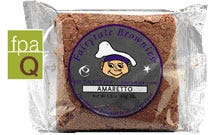 Fairytales don't usually end with brownie wrappers, but a portion-pack film wrap for Fairytale Brownies® created a happy ending for Alcan Packaging (Q), which won a silver award for technical innovation for its Ceramis® internally developed and manufactured SiO2-coated film used to extend the shelf life of the brownies while maintaining the clarity.
Fairytales don't usually end with brownie wrappers, but a portion-pack film wrap for Fairytale Brownies® created a happy ending for Alcan Packaging (Q), which won a silver award for technical innovation for its Ceramis® internally developed and manufactured SiO2-coated film used to extend the shelf life of the brownies while maintaining the clarity.
Created 10 years ago by childhood friends, Fairytale Brownies was looking to improve the packaging for its individually wrapped, baked-from-scratch brownies. "We wanted to eliminate the machine-printed label that had to be applied separately, and go with preprinted film," says co-owner David Krevitz. "The labeling process required a full-time person to watch the registration on the package, and we needed more space to list ingredients on the labels."
The challenge for Alcan Packaging was first to print a metallized-label look (purple ink on a silver background) that stays consistent for brand recognition. The other challenge was to increase the barrier properties of the package, thus allowing for new market penetration by enabling increased shelf life, and therefore greater geographic market distribution.
To simulate the look of the previous package's adhered metallic sticker, Alcan worked with Eckart America's Ultrastar® inks to offer the look of a metallized label without the limitations. The first commercial application of the new ink system, the six-color flexo printing job "surpasses the appearance of a foil label," while reverse printing eliminates abrasion the previous labels suffered, Alcan reports. The company adds that the package is also said to provide a clean, quality look and more product information and costs less than a nonmetallic structure.
In addition, the reverse printing is not subject to abrasions during shipping as the label was. Bar codes as well as nutritional information were added to the back of the package, which then allowed for larger graphics elements on the front of the package.
The opening of the package is also enhanced with a micro zig-zag edge on a crimp seal. Alcan worked very well for us. I was greatly impressed by their professionalism and their attention to detail," says Kravetz. "Their film has a better barrier and more space for printing, and the metallic-looking ink is perfect." Circle No. 247.
Clothing tape protects against hazardous chemicals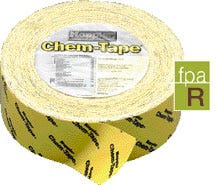 Kappler's Chem-Tape® is a most unusual FPA entry (R). The proprietary, chemically resistant adhesive tape made with a multilayer film lamination from Cadillac Products Packaging, won a silver award for technical innovation. Suitable for use with high-barrier, chemically protective clothing worn by those handling and exposed to hazardous liquid chemical and warfare agents, the patented tape revolutionized the protective clothing market as the first designed and tested specifically for chemical protective clothing applications. Manufactured by Kappler Corp., in its plant in Guntersville, AL, Chem-Tape adds a barrier to hazardous chemicals at the seams and openings of clothing when mid- to high-range chemical protection is needed.
Kappler's Chem-Tape® is a most unusual FPA entry (R). The proprietary, chemically resistant adhesive tape made with a multilayer film lamination from Cadillac Products Packaging, won a silver award for technical innovation. Suitable for use with high-barrier, chemically protective clothing worn by those handling and exposed to hazardous liquid chemical and warfare agents, the patented tape revolutionized the protective clothing market as the first designed and tested specifically for chemical protective clothing applications. Manufactured by Kappler Corp., in its plant in Guntersville, AL, Chem-Tape adds a barrier to hazardous chemicals at the seams and openings of clothing when mid- to high-range chemical protection is needed.
The product is a high-performance, proprietary five-layer lamination consisting of outer layers of PE, a core layer of EVOH and adhesive layers between the EVOH and PE layers. This structure is converted into a narrow yellow tape, on rolls 2 in. wide 3 60 yd long, packed 24 rolls per case.
The tape can be used to cover storm flaps, sleeve cuffs and other openings present in protective clothing. The films and lamination provide good cross tearability, a critical issue for such a tape product. Cadillac Products says it developed and incorporated differential surface characteristics on both sides of the films and lamination to ensure excellent lamination and good adhesion between the film, the adhesive and the cloth scrim, while providing an easy, clean unwind of the finished tape roll from itself.
Lab testing for Kappler showed the lamination had normalized breakthrough times greater than 480 minutes on many aggressive chemicals.
Development of the tape came from an inherent need within the hazardous materials handling community for a product improvement. After years of using traditional duct tapes, Kappler says it began investigating the possibility of upgrading the chemical-resistance of conventional PE-based duct tape, by utilizing the wide chemical-resistance offered by multilayer film barriers already in use within the existing chemical protective clothing market. The proprietary, chemically resistant outer barrier ply of the tape lamination protects the reverse-printed graphics and colored background from deterioration from chemical exposure and ensures that the supplier's name and brand identification remain clear and visible to end users. Circle No. 248.
Kool-Aid's see-through pouch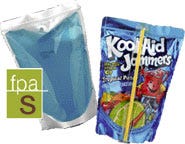 Kool-Aid® Jammers is a new fun-filled juice drink from Kraft in an equally interesting standup pouch (S). Made with a film material from Pliant Corp. that produces a transparent back panel, the pouch is fun for kids to drink from as they watch the product splash around inside. The pouch won a silver award in technical innovation. Converter Alcan Packaging uses the Pliant films as sealant and barrier layers to make an adhesive-laminated pouchstock for the 200-mL (6.75-oz) drink package. Alcan says the pouch is actually made of two different film structures.
Kool-Aid® Jammers is a new fun-filled juice drink from Kraft in an equally interesting standup pouch (S). Made with a film material from Pliant Corp. that produces a transparent back panel, the pouch is fun for kids to drink from as they watch the product splash around inside. The pouch won a silver award in technical innovation. Converter Alcan Packaging uses the Pliant films as sealant and barrier layers to make an adhesive-laminated pouchstock for the 200-mL (6.75-oz) drink package. Alcan says the pouch is actually made of two different film structures.
Pliant's director of corporate communications John McCurdy tells PD that the barrier layer consists of a five-layer, clear blown EVOH film laminated to a clear polyester that creates the pouch's clear back. He says the unique structure also had to be durable enough to withstand the high temperatures required for filling the package.
The front panel and the bottom of the pouch are made with another clear polyester outer layer, adhesive-laminated to a foil layer and then adhesive-laminated to a sealant, the same type of five-layer EVOH structure as the barrier layer on the back of the pouch, Alcan says.
The foil adds glitz to the luxurious graphics that Alcan reverse-prints by gravure in six colors, while the barrier layers are noted to provide shelf stability without vitamin or flavor loss. Kool-Aid Jammers is a good choice for school lunch boxes and on-the-go refreshment. Equipped with a straw attached to the package, the product, in six flavors, allows kids to watch the bright colors of their juice drink disappear, sip by sip. Flavors include Tropical Punch, Grape, Cherry and Kiwi Strawberry. Ten of the pouches are multipacked in a vividly decorated, proprietary carton. The Kool-Aid Man, who has graced the packages of Kool-Aid for 26 years, is pictured on the packages demonstrating in-line skating, biking, skateboarding and snowboarding.
Launched in October, '0l, the Kool-Aid Jammers pack is a hit with kids, says John Craig, senior brand manager at Kraft Foods. "Kids love the pouch. It has great play value because kids like to interact with the product and they love to be able to see how much product is left while they're drinking. We wanted to bring a new innovation to the aseptic juice drink category. Vibrant [product] colors are a core equity for Kool-Aid, and we knew kids would love to see them." Circle No. 249.
Baby bottle liner tackles freezing and thawing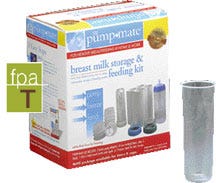 Pump-Mate baby bottle liners earned PBM Plastics, Inc. a silver award in technical innovation. The Pump-Mate breast milk storage and feeding system (T), from Newport News, VA-based Pump-Mate Co., offers convenience with durability. Available since December, the "extra-thick" film liner was designed to endure freezing and thawing, allowing busy moms to pump breast milk, freeze it and feed an infant using one bottle liner.
Pump-Mate baby bottle liners earned PBM Plastics, Inc. a silver award in technical innovation. The Pump-Mate breast milk storage and feeding system (T), from Newport News, VA-based Pump-Mate Co., offers convenience with durability. Available since December, the "extra-thick" film liner was designed to endure freezing and thawing, allowing busy moms to pump breast milk, freeze it and feed an infant using one bottle liner.
PBM produces the LDPE liner using a food-grade resin from ExxonMobil and a patented melt-phase forming process in which it combines traditional blow molding and thermoforming with a billet, or precut film, heated to the melt phase and molded. Drawn to a depth of approximately 6 in., the resulting liner is .0035 in. thick and can withstand temperatures to 0 deg F.
PBM's marketing communications manager Celeste Vaughn says that advantages of the manufacturing process are deeply drawn containers and liners with up to a 6:1 ratio of even material distribution throughout the entire cross section of the liner and precision flanges as a result of forming from a precut billet. "The liner-forming process generates bottle liners with a high degree of integrity, because it takes the LDPE material to elevated temperatures and eliminates stresses inherent in other types of formed containers," she tells PD. "The seamless liner virtually eliminates leaks by removing stress points."
Vaughn says independent lab testing indicates that compared to other baby bottle liners, this one demonstrates 15-percent better impact-resistance and 28-percent better compressive strength. "The systems in place today allow milk to be expressed into disposable liners, but they aren't easily stored after that," notes Vaughn. The liners are presterilized by gamma radiation. PBM overwraps them in counts of 10 in a clear polypropylene film for insertion into a starter kit. The kit includes a four-liner caddy molded of PE that can be placed in the freezer. Packed in an SBS folding carton, the starter kit also comes with pump adapters, caps, labels, and a wide-mouth, 8-oz bottle with nipple. The package also includes usage instructions and a handy brochure. The storage unit and capping process are unique to PBM, Vaughn says. "They're designed to easily hold filled liners, which can be easily sealed inside the bottle or storage device."
The liners can also be thawed and dropped into any wide-mouth bottle for feeding, without having to transfer milk from one bottle to another. Available nationally at mass-merchandise stores, online and through childbirth educators, the product is already a success in the first few months of its introduction, says Adam Burke, president of Pump-Mate. "We have had hundreds of testimonials from moms about this product. The response to it has been amazing. It turns any breast pump into a complete feeding system." Circle No. 250.
Melting ice was never so easy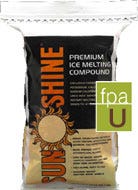 Last but certainly not least, the Sun Shine Ice Melting Compound Bag (U) is a new standalone, heavy-duty reclosable sack with a built-in handle, a string-pull opening and a reclosable zipper. The integral die-cut handle is one addition that makes this 50-lb bag easier to lift and carry. Winning Plassein Intl. a silver award in technical innovation, the bag has been available primarily in the Midwest since the fall of '02.
Last but certainly not least, the Sun Shine Ice Melting Compound Bag (U) is a new standalone, heavy-duty reclosable sack with a built-in handle, a string-pull opening and a reclosable zipper. The integral die-cut handle is one addition that makes this 50-lb bag easier to lift and carry. Winning Plassein Intl. a silver award in technical innovation, the bag has been available primarily in the Midwest since the fall of '02.
Marketed through janitorial suppliers, the ice-melting flakes are manufactured and packaged by Frank Miller and Sons, Riverdale, IL. An open-mouth, tubular-style structure, the bag is made from what Plassein's Craig Miller describes as a 5-mil, unsupported, linear low-density PE with an ultraviolet (UV)-inhibitor additive. The film is stronger than LDPE, he says, provides good seals, and endures the elements and rough handling well. Plassein's facility in Thomasville, NC, extrudes the bag material and surface-prints it in three colors on a six-color Uteco flexo stack press before the material is made into tubular bags on Amplas equipment.
During bagmaking, Plassein embosses two vertical rows on the bag surface with rollers to provide an anti-skid surface and allow the bags to interlock when being stacked onto a pallet and prevent them from sliding. This also makes the bags easier to stack than the previous packaging, which included a standalone heavy-duty sack that wasn't reclosable. Plassein sends the bags to Erlanger, KY, where MDH Packaging attaches a header to the bag. The header features a convenient rip-n-zip tearstrip opening and zipper closure device and a die-cut handle. From there, the bags are shipped to Frank Miller and Sons where they are semi-automatically bottom-filled and sealed on Chantland-PVS equipment. Jim Miller, of Frank Miller and Sons, says, "Consumers like the new bag, especially those who don't use up the entire contents at once and need to reseal it. The bag really helps protect the product's formulation throughout its usage life." Circle No. 251.
More information is available:
Awards Program: Flexible Packaging Assn., 410/694-0800. Circle No. 252.
Pudding stick pack, fruit cup lidding, 24-pack film wrap: Curwood/Bemis Polyethylene Packaging Div., 920/303-7300. Circle No. 253.
Microwavable tray package: Cryovac Div., Sealed Air Corp., 864/433-2000. Circle No. 254.
Dietary supplement pack: Rollprint Packaging Products, 630/628-1700. Circle No. 255.
Retortable rice pouch: CLP Industries, Ltd., 973/808-4441. Circle No. 256.
Beech-Nut pouch: Amgraph Packaging, Inc., 860/822-2014. Circle No. 257.
Ore-Ida bag, Kool-Aid pouch: Pliant Corp., 866/878-6188. Circle No. 258.
Full-body shrink-sleeve labels: SleeveCo, Inc., 706/216-3110. Circle No. 259.
Potsickers pouch: Nordenia USA, Inc., 573/335-4900. Circle No. 260.
Aseptic gravity flow valve: International Dispensing Corp., 410/729-0125. Circle No. 261.
Gerber entrées lidding, dog treats pouch: Pechiney Plastic Packaging, 773-399-8000. Circle No. 262.
Apple juice concentrate pouch: Peruplast S.A., 511/348-3777. Circle No. 263.
Grout pack: Specialty Films & Associates, LLC, 859/647-4100. Circle No. 264.
Rice chips bag: Progressive Packaging, 905/727-0121. Circle No. 265.
Brownie wrapper: Alcan Packaging, 847/498-7600. Circle No. 266.
Adhesive tape lamination: Cadillac Products Packaging Co., 800/837-0055. Circle No. 267.
Baby bottle liner: PBM Plastics, Inc., 757/888-6800. Circle No. 268.
Ice melter bag: Plassein Intl., 860/429-5070. Circle No. 269.
About the Author(s)
You May Also Like


